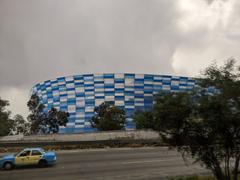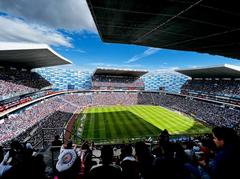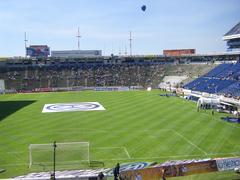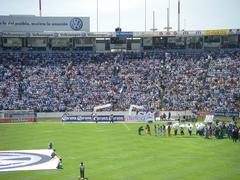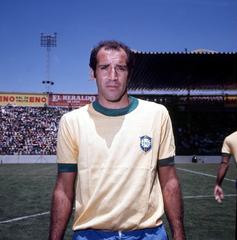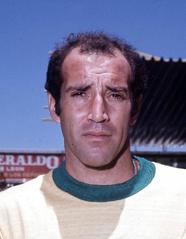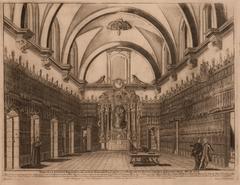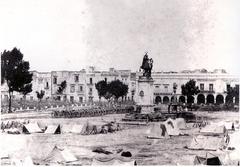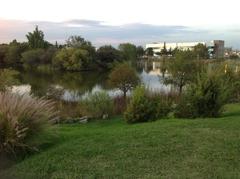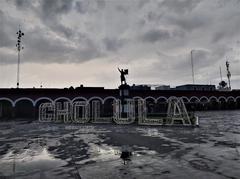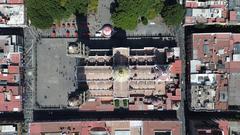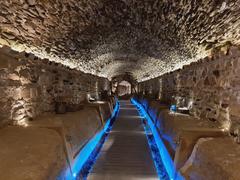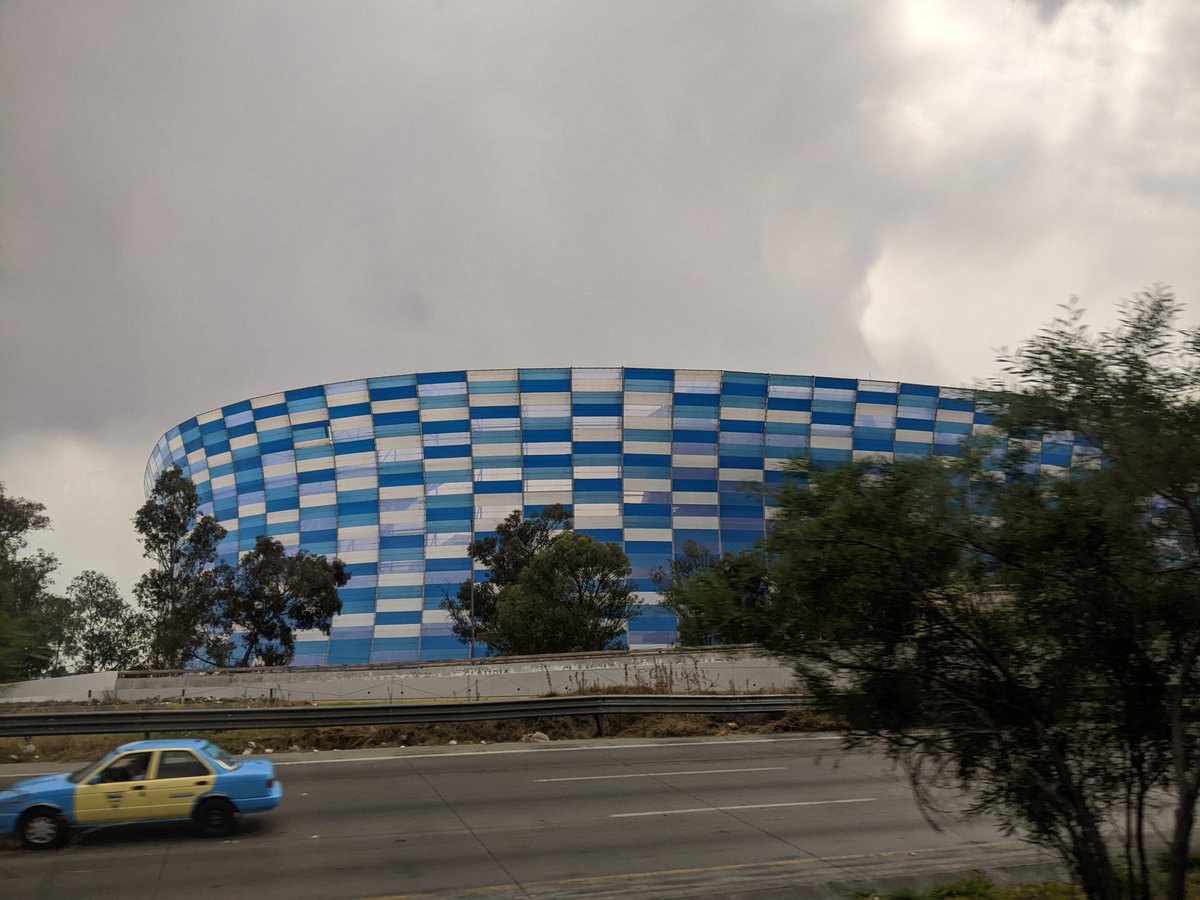
Estadio Cuauhtémoc: Visiting Hours, Tickets, and Puebla City Historical Sites Guide
Date: 14/06/2025
Introduction
Estadio Cuauhtémoc, an architectural icon in Puebla City, Mexico, is renowned for its blend of historical resonance, innovative design, and vibrant sporting culture. Since its inauguration in 1968, the stadium has become a premier destination for both football fans and cultural explorers, offering not only exhilarating matches but also a window into the city’s rich heritage. This comprehensive guide provides essential information on Estadio Cuauhtémoc’s visiting hours, ticketing, accessibility, travel tips, and nearby attractions, helping you make the most of your visit to this remarkable venue and the historic city of Puebla.
1. History and Cultural Significance
Origins and Development
Estadio Cuauhtémoc was conceived in the mid-1960s by celebrated Mexican architect Pedro Ramírez Vázquez, whose portfolio includes the Estadio Azteca and the Basilica of Our Lady of Guadalupe. Funded by the Cuauhtémoc-Moctezuma Brewery and named in honor of Cuauhtémoc, the last Aztec emperor, the stadium was inaugurated on October 6, 1968, during the pre-events of the 1968 Summer Olympics. Its initial capacity was 35,000 spectators, marking it as a beacon of modern sports infrastructure in Puebla (EstadiosFC, Football Tripper).
Architectural Evolution
Original Design
Ramírez Vázquez’s original circular design prioritized unobstructed views and a superior spectator experience, using modernist concrete forms characteristic of the era.
Expansions and Renovations
- 1970 and 1986 FIFA World Cups: The stadium underwent significant expansions to host World Cup matches, increasing capacity and modernizing facilities.
- 2014–2015 Renovation: Led by Dünn Lightweight Architecture and Acapro de Hidalgo SA de CV, this renovation introduced an ETFE (ethylene tetrafluoroethylene) façade—the first of its kind in Mexico and Latin America—expanding capacity to 51,726 and transforming the stadium’s visual identity while improving energy efficiency (Futbol-Pro).
Cultural Symbolism
Named after Cuauhtémoc, the stadium symbolizes indigenous pride and resilience. Its design incorporates motifs inspired by Puebla’s renowned pottery and tilework, making it a local cultural landmark. The stadium is affectionately known as “El Coloso de Maravillas” and serves as the home ground for Club Puebla, whose fans, “La Franja,” are renowned for their passionate support (Futbol-Pro).
2. Location and Accessibility
Geographic Location
Estadio Cuauhtémoc is located in Puebla City’s northeast sector, approximately six kilometers from the UNESCO-listed Historic Centre. The official address is Calzada Ignacio Zaragoza 222, Colonia Maravillas, C.P. 72220, Puebla, Puebla, Mexico (Google Maps).
Transportation
- Public Transit: The stadium is served by multiple city bus routes, including RUTA Line 1, and is accessible via taxis and ride-sharing services (Visit Puebla).
- Parking: On-site parking accommodates around 3,000 vehicles; fees vary by event. Overflow parking is available nearby.
- Cyclists and Pedestrians: Bicycle racks and BiciPuebla stations are available; wide sidewalks and crosswalks facilitate pedestrian access.
Accessibility for People with Disabilities
Post-renovation, Estadio Cuauhtémoc meets modern accessibility standards, featuring ramps, elevators, accessible restrooms, and reserved parking (Estadio Cuauhtémoc Renovation).
3. Visiting Hours and Tickets
Visiting Hours
- Non-Match Days: Guided tours are available Tuesday through Sunday, typically from 10:00 AM to 4:00 PM. Confirm schedules on the official Club Puebla website.
- Match Days: Gates open 2–3 hours prior to kickoff; early arrival is advised.
Ticket Information
- Match Tickets: Available online via Club Puebla’s website, authorized vendors, or at the stadium box office. Prices range from 100 to 600 MXN, depending on the event and seating selection.
- Guided Tours: Tickets start from approximately 150 MXN per person and should be booked in advance.
Event Day Tips
- Arrive early for popular matches or events to secure parking and avoid crowds.
- Review the stadium’s prohibited items list before arrival for a smooth entry experience.
4. Stadium Architecture and Facilities
Design Features
- ETFE Façade: The unique, translucent ETFE skin reduces steel usage and enhances natural light, creating a striking exterior.
- Capacity: The stadium seats up to 51,726 spectators, with unobstructed sightlines from four main stands.
- Modern Amenities: Includes VIP boxes, accessible seating, modern restrooms, food and beverage concessions, and merchandise shops (433Futbol).
Safety and Security
- Surveillance systems, security personnel, and clear bilingual signage ensure visitor safety and smooth navigation.
5. Match Day Atmosphere and Cultural Experience
Estadio Cuauhtémoc is famed for its electric match day atmosphere. Club Puebla’s supporters fill the stadium with chants, banners, and blue-and-white colors. The stadium’s altitude (approximately 2,175 meters) adds a unique challenge for players and visitors alike (Ultimate Travel Advice).
6. Food, Beverages, and Amenities
A variety of local and international snacks—including tacos, tortas, and elotes—are available throughout the stadium. Beverage stalls serve soft drinks, water, and beer (where permitted). Facilities include accessible restrooms, family-friendly areas, and first aid stations.
7. Guided Tours and Behind-the-Scenes Access
Guided tours offer insights into the stadium’s architecture and history, with access to locker rooms, press areas, and VIP suites. Tour schedules vary; check with the stadium or Touristlink for details.
8. Nearby Attractions and Photographic Spots
Visitors can easily explore nearby Puebla attractions:
- Puebla Historic Centre: Colonial architecture, vibrant plazas, and museums.
- Puebla Cathedral and Amparo Museum: Among the city’s top historical sites.
- Estadio Hermanos Serdán: For baseball fans.
- Parque Ecológico Revolución Mexicana: Ideal for relaxation and city views.
The stadium’s ETFE façade, murals, and elevated vantage points offer excellent photo opportunities.
9. Travel Tips and Visitor Essentials
- Language: Spanish is predominant; bilingual signage is common.
- Currency: Mexican peso; bring cash for small purchases.
- Weather: Puebla’s climate is mild but can be cool at night; bring a jacket or rain poncho during rainy season.
- Altitude: At over 2,100 meters, stay hydrated and acclimate if sensitive to high elevations.
- Safety: The stadium and surrounding area are generally safe, but standard precautions apply.
10. Sustainability Initiatives
Recent renovations incorporated energy-efficient lighting and waste management systems. Visitors are encouraged to use recycling bins and participate in sustainability efforts.
11. Frequently Asked Questions (FAQs)
What are Estadio Cuauhtémoc’s opening hours?
Non-match day tours: 10:00 AM–4:00 PM, Tuesday–Sunday; match day gates open 2–3 hours before kickoff. Confirm with official sources.
How do I buy tickets?
Purchase online at Club Puebla’s website, authorized vendors, or at the stadium box office.
Is the stadium accessible?
Yes, with ramps, elevators, accessible seating, restrooms, and reserved parking.
Are guided tours available?
Yes, on select days; booking in advance is recommended.
What are nearby attractions?
Historic Centre, Puebla Cathedral, Amparo Museum, parks, and shopping centers.
12. Summary Table: Quick Facts
| Feature | Details |
|---|---|
| Address | Calzada Ignacio Zaragoza 222, Col. Maravillas, Puebla, Mexico |
| Public Transit | RUTA Line 1, city buses, taxis, ride-sharing |
| Parking | On-site (3,000 spaces), nearby overflow lots |
| Accessibility | Wheelchair ramps, elevators, accessible restrooms, reserved parking |
| Capacity | 51,726 |
| Altitude | ~2,175 meters (7,136 ft) above sea level |
| Nearby Attractions | Historic Centre, Puebla Cathedral, Amparo Museum, Parque Ecológico |
13. Conclusion and Call to Action
Estadio Cuauhtémoc is more than a sporting venue—it’s a cultural landmark that bridges Puebla’s ancient heritage and contemporary vibrancy. Whether you’re attending a match, touring its innovative architecture, or exploring the city’s colonial treasures, the stadium offers a memorable experience for every visitor.
Plan ahead by checking official channels for tickets and hours, and take advantage of the Audiala app for the latest updates, events, and travel tips. Engage with Puebla’s rich culture, join the passionate local fans, and discover why Estadio Cuauhtémoc remains a symbol of pride and unity in Mexico.
Sources
- EstadiosFC
- Football Tripper
- Futbol-Pro
- Visit Puebla
- Google Maps
- Club Puebla
- Touristlink
- Ultimate Travel Advice
- 433Futbol
- Audiala app
